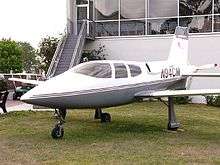Cirrus VK-30
| VK-30 | |
|---|---|
 | |
| Role | Amateur-built airplane |
| National origin | United States |
| Manufacturer | Cirrus Design |
| Designer | Jeff Viken, Alan and Dale Klapmeier |
| First flight | 11 February 1988 |
| Introduction | 1987[1] |
| Number built | about 13 |
| Unit cost |
$64,000 USD (Airframe kit without engine in 1995) |


The Cirrus VK-30 is a single-engine pusher-propeller homebuilt aircraft originally sold as a kit by Cirrus Design (now called Cirrus Aircraft), and was the company's first model.[2]
As a kit aircraft the VK-30 is a relatively obscure design with few completed aircraft flying. Its most important legacy is that the work done on developing and marketing the aircraft convinced the designers that the best way to proceed in the future was with a more conventional layout and with a certified production aircraft. Thus the lessons of the VK-30 were directly responsible for the design of the Cirrus SR20 and SR22, which have been the best-selling four-to-five-seat fixed wing aircraft in the world for the last 13 consecutive years.[3][4][5]
Design and development
The VK-30 design was conceived in the early 1980s as a kit plane project by three college students, Jeff Viken and Alan Klapmeier from Wisconsin’s Ripon College, and Alan's brother, Dale Klapmeier, who was attending the University of Wisconsin at Stevens Point. Jeff Viken's wife, Sally, designed the VK-30’s flap system. Together, in the Klapmeiers' parents' barn in rural Sauk County, Wisconsin,[6] they formed Cirrus Design as the company to produce the VK-30 (VK standing for Viken-Klapmeier).[1][2]
The aircraft has an all-composite construction, and was designed to achieve natural laminar flow over the fuselage as well as the wing and tail surfaces to provide a very low-drag design—using a NASA NLF(1)-0414F airfoil. The prototype incorporated some parts from production aircraft, including the nose gear from a Piper Cherokee and the main landing gear from a Lake LA-4. The VK-30 was designed to be a five-seat aircraft from the start, which made it considerably larger than most other amateur-built aircraft of its day. It incorporated a mid-engine design, driving a three-bladed pusher propeller behind the tail through an extension shaft. The powerplant was a Continental IO-550-G developing 300 hp (224 kW).[2][7]
The VK-30 first flew on 11 February 1988 and kit deliveries commenced shortly thereafter.[2]
Cirrus discontinued production of the VK-30 towards the end of 1993.[8]
In 1996 the company announced plans to develop a stronger replacement wing for about 28 VK30s supplied to past customers.[8]
Operational history
Cirrus delivered 40 kits, and built four additional factory prototypes.[1] The company estimated that there were 13 customer VK-30s completed and as of February 2016 six were still registered with the Federal Aviation Administration in the USA.[2][9]
Accidents
On 22 March 1996, retired astronaut Robert F. Overmyer died at age 59 in the crash of an Allison turbine-powered VK-30. He was testing the aircraft for stall recovery characteristics at aft center of gravity limits.[8][10]
Aircraft on display
Specifications (VK-30)
Source: EAA AirVenture Museum[12]
General characteristics
- Crew: one pilot
- Capacity: four passengers
- Length: 26 ft 0 in (8.00 m)
- Wingspan: 39 ft 8 in (12.20 m)
- Height: 10 ft 8 in (3.28 m)
- Wing area: 126 ft² (11.7 m²)
- Empty weight: 2400 lb (1087 kg)
- Loaded weight: 3,600 lb (1630 kg)
- Max. takeoff weight: 3,600lb (1630kg)
- Powerplant: 1 × Continental IO-550-G constant speed, 300hp (223 kW)
Performance
- Maximum speed: 250 mph at sea level (405 km/h)
- Range: 1,300 statute miles (2,106 km)
- Rate of climb: 1,500 ft/min (7.7 m/s)
- Wing loading: 28.6 lb/ft² (143 kg/m²)
See also
- Aircraft of comparable role, configuration and era
- Related lists
References
- 1 2 3 Gustafson, David. "The Klapmeier Brothers - Homebuilts to Factory Builts" (PDF). Retrieved 2014-09-29.
- 1 2 3 4 5 6 EAA Aviation Center (n.d.). "Cirrus Design Corporation VK-30 – N33VK". Retrieved 2008-02-10.
- ↑ Durden, Rick (21 February 2014). "2013: A Good Year for Cirrus". AVweb. Retrieved 24 February 2014.
- ↑ Cirrus Aircraft News (February 11, 2015). "Cirrus Aircraft Deliveries in 2014 Drive Strongest Performance in Six Years". Retrieved March 1, 2015.
- ↑ "Rare Airplanes in Flight". Retrieved 16 September 2015.
- ↑ Airport Journals Staff (January 2007). "Cirrus Design's Alan and Dale Klapmeier: "Dumb Enough to Start and Smart Enough to Finish"". Airport Journals. Retrieved 30 March 2014.
- ↑ Lednicer, David (October 2007). "The Incomplete Guide to Airfoil Usage". Retrieved 2008-12-29.
- 1 2 3 Warwick, Graham (April 1996). "Former astronaut killed in Cirrus VK30 test crash". Retrieved 2016-01-29.
- ↑ Federal Aviation Administration (2 February 2016). "Make / Model Inquiry Results". Retrieved 2 February 2016.
- ↑ National Transportation Safety Board (March 1996). "NTSB Identification: CHI96FA116". Retrieved 2008-02-10.
- ↑ Steen Aero Lab (April 2006). "Event Reports - Sun 'N Fun 2006". Retrieved 3 April 2011.
- ↑ EAA Aviation Center (n.d.). "Cirrus VK-30 Specifications". Retrieved 2008-02-10.
External links
![]() Media related to Cirrus VK-30 at Wikimedia Commons
Media related to Cirrus VK-30 at Wikimedia Commons